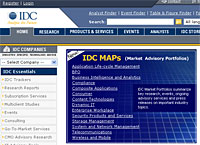 According to a study by IDC, instant messaging in the business world is going bonkers and looks set to continue its huge growth, but experts are warning of security risks.
According to a study by IDC, instant messaging in the business world is going bonkers and looks set to continue its huge growth, but experts are warning of security risks.
Their research found that the worldwide enterprise instant messaging market (which includes instant messaging server products as well as enterprise instant messaging security, compliance, and management products) leapt 37% in terms of year-over-year revenue in 2004, and is expected to skyrocket from $315 million in 2005 to $736 million in 2009.
“With more than 28 million business users worldwide using enterprise instant messaging products to send nearly 1 billion messages each day in 2005, and many more crossover corporate consumers who use consumer instant messaging networks in the workplace, these products are clearly reaching more mainstream users,” said Robert P. Mahowald, program director for IDC’s Collaborative Computing research.
“Especially in compliance-driven sectors like Wall Street, financial services, and government, instant messaging is a critical differentiator. In the next few years, IDC expects instant messaging – once the plaything of teenagers – to continue to grow into its role as a substantial business collaboration application,” he added
 The growth in the enterprise segment is being fuelled by domestic users of IM tools like MSN Messenger bringing their online chatting habits into the work place and using the service as a business collaboration tool.
The growth in the enterprise segment is being fuelled by domestic users of IM tools like MSN Messenger bringing their online chatting habits into the work place and using the service as a business collaboration tool.
The report identified financial services and the public sector as the keenest to take up enterprise IM, with business IM monitoring and archiving tools able to keep a watchful eye on yapping employees.
According to a recent Gartner poll, instant messaging is now used in 70% of all companies, but figures from the Yankee Group reveal that only 15-20% of those companies operate IM administration, leaving 50% of office IM use unmonitored.
This wouldn’t appear to be the brightest idea as a new IMLogic study reveals that an increasing number of virus authors are starting to focus on IM clients as virus spreading agents.
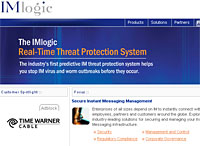 IMLogic says that the attacks on the IM clients have reached record values – up 14 times on last year – with the complexity of the attacks also increasing.
IMLogic says that the attacks on the IM clients have reached record values – up 14 times on last year – with the complexity of the attacks also increasing.
The company’s IM monitoring service showed that MSN Messenger suffered the highest attack rate at 62% of the reported cases, with AOL’s AIM client coming at second with 31% of the attacks and Yahoo third with 7% of the attacks targeting their client.
IMLogic’s research found that the majority of the attacks were worm-based (87%) with 12% of the attacks aimed at spreading a virus.
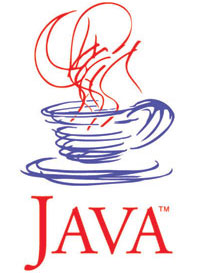 Google and Sun Microsystems have come up with a broad, but fuzzy, deal which will see the two companies developing and distributing each other’s technology in a move to challenge Microsoft’s Office suite dominance.
Google and Sun Microsystems have come up with a broad, but fuzzy, deal which will see the two companies developing and distributing each other’s technology in a move to challenge Microsoft’s Office suite dominance.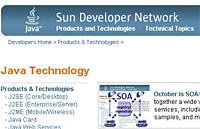 It’s also expected that the deal will make it easier for freeloading punters to obtain OpenOffice, Sun’s well-regarded, freely distributed office productivity suite which directly competes with Microsoft Office.
It’s also expected that the deal will make it easier for freeloading punters to obtain OpenOffice, Sun’s well-regarded, freely distributed office productivity suite which directly competes with Microsoft Office.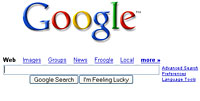 Bundling the two products together seems a wise move, increasing the appeal of the Google Toolbar and making Java a more attractive proposition for software developers.
Bundling the two products together seems a wise move, increasing the appeal of the Google Toolbar and making Java a more attractive proposition for software developers.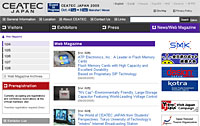 Japan’s largest annual IT show, Ceatec (Combined Exhibition of Advanced Technologies), opens today and will feature around 700 companies, according to the organisers.
Japan’s largest annual IT show, Ceatec (Combined Exhibition of Advanced Technologies), opens today and will feature around 700 companies, according to the organisers.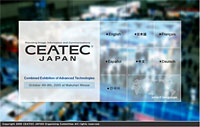 Toshiba has promised to display a super-slim 12.7 millimetre high drive designed for laptops which can read HD-DVD discs and read and write DVDs and CDs.
Toshiba has promised to display a super-slim 12.7 millimetre high drive designed for laptops which can read HD-DVD discs and read and write DVDs and CDs. We saw it with the Internet in the late 90s and iTV in the early noughties, now mobile TV is the disruptive technology du jour.
We saw it with the Internet in the late 90s and iTV in the early noughties, now mobile TV is the disruptive technology du jour.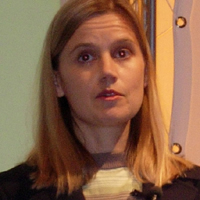 It’s easy to be swept up in the hype, and persuasive arguments abound.
It’s easy to be swept up in the hype, and persuasive arguments abound. Claire Tavernier from Fremantlemedia (right), owner of Neighbours and Baywatch, said “Fremantle TV” would launch on US mobile networks before the end of the year.
Claire Tavernier from Fremantlemedia (right), owner of Neighbours and Baywatch, said “Fremantle TV” would launch on US mobile networks before the end of the year. But is the industry is in danger of death by over-sell before it’s even arrived?
But is the industry is in danger of death by over-sell before it’s even arrived? This is all sounding very familiar – we’ve been here before. As with the early days of the Internet and iTV, business models are unclear. Hurdles include lack of appropriate content – including rights clearance on existing properties, lack of spectrum and unproven consumer demand.
This is all sounding very familiar – we’ve been here before. As with the early days of the Internet and iTV, business models are unclear. Hurdles include lack of appropriate content – including rights clearance on existing properties, lack of spectrum and unproven consumer demand.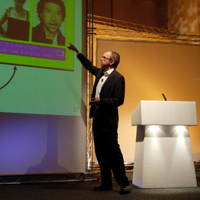 Tavernier also talked about rights, revealing that although Fremantlemedia owned worldwide TV rights to Mr Bean and The Benny Hill Show, both Rowan Atkinson and Benny Hill’s widow had said no to mobile distribution.
Tavernier also talked about rights, revealing that although Fremantlemedia owned worldwide TV rights to Mr Bean and The Benny Hill Show, both Rowan Atkinson and Benny Hill’s widow had said no to mobile distribution.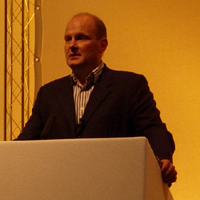 The most telling figures came in the final session of the conference: “Viewers don’t see their mobile as an entertainment device” said Enpocket’s Jeremy Wright (right). “They see it first and foremost as a communicator.”
The most telling figures came in the final session of the conference: “Viewers don’t see their mobile as an entertainment device” said Enpocket’s Jeremy Wright (right). “They see it first and foremost as a communicator.” Britain’s biggest cable operator, NTL, has agreed to shell out an eye-watering $6 billion (~£3.42bn, ~€5bn) for Telewest Global.
Britain’s biggest cable operator, NTL, has agreed to shell out an eye-watering $6 billion (~£3.42bn, ~€5bn) for Telewest Global. According to a statement – which ends three years of speculation about the merger – Simon Duffy, NTL’s chief executive, will lead the combined company.
According to a statement – which ends three years of speculation about the merger – Simon Duffy, NTL’s chief executive, will lead the combined company.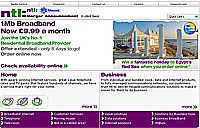 Chairman Cob Stenham can expect his bank balance to increase to the tune of $20m (~£11.4m, ~€16.77m) while chief executive Barry Ellison will no doubt cackle wildly with joy as $17m (~£9.7m, ~€14.25m) rolls into his coffers.
Chairman Cob Stenham can expect his bank balance to increase to the tune of $20m (~£11.4m, ~€16.77m) while chief executive Barry Ellison will no doubt cackle wildly with joy as $17m (~£9.7m, ~€14.25m) rolls into his coffers.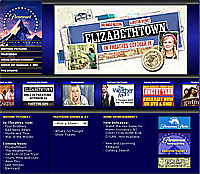 As the next-generation DVD wars between HD-DVD and Blu-ray Disc grind on, Paramount Home Entertainment has employed a time-honoured fudge and announced that it will be offering movies in both formats.
As the next-generation DVD wars between HD-DVD and Blu-ray Disc grind on, Paramount Home Entertainment has employed a time-honoured fudge and announced that it will be offering movies in both formats.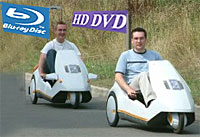 Both formats serve up far more storage capacity than current DVD discs, with HD-DVD offering 15GB or 30GB and Blu-ray Disc 25GB or 50GB, depending on the disc.
Both formats serve up far more storage capacity than current DVD discs, with HD-DVD offering 15GB or 30GB and Blu-ray Disc 25GB or 50GB, depending on the disc.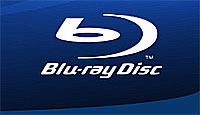 Paramount was one of the first major content players to back the Toshiba/NEC-developed HD-DVD format, with other major backers including Warner Home Video, HBO, New Line Cinema, Universal Pictures and Sanyo Electric, followed by Intel and Microsoft last week.
Paramount was one of the first major content players to back the Toshiba/NEC-developed HD-DVD format, with other major backers including Warner Home Video, HBO, New Line Cinema, Universal Pictures and Sanyo Electric, followed by Intel and Microsoft last week.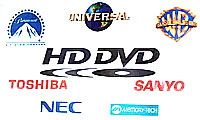 Influential in Paramount’s decision was the PlayStation 3’s support for Blu-ray Disc.
Influential in Paramount’s decision was the PlayStation 3’s support for Blu-ray Disc. Happy Birthday!
Happy Birthday! I found a screenshot of what Google used to look like on the Internet archive, and although it does obviously look a little old-school, it’s still much the same interface-wise as it is today:
I found a screenshot of what Google used to look like on the Internet archive, and although it does obviously look a little old-school, it’s still much the same interface-wise as it is today: It’s in Space, it’s got to be cool. Oh, actually, no nukes, so forget it
It’s in Space, it’s got to be cool. Oh, actually, no nukes, so forget it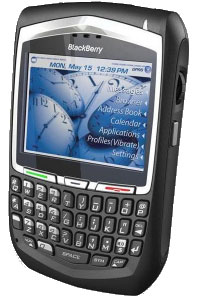 “Batman’s Blackberry”, but I still want one!
“Batman’s Blackberry”, but I still want one!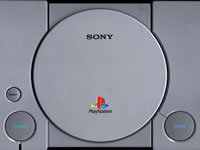 Sony’s Playstation has been awarded an Emmy for Outstanding Achievement in Technology and Advanced New Media for pioneering the 3D polygonal-based gaming experience, by the US National Academy of Television Arts and Sciences (NATAS).
Sony’s Playstation has been awarded an Emmy for Outstanding Achievement in Technology and Advanced New Media for pioneering the 3D polygonal-based gaming experience, by the US National Academy of Television Arts and Sciences (NATAS). You can imagine that the awarding of this will make steam come out of the ears of those on the Xbox team at Microsoft
You can imagine that the awarding of this will make steam come out of the ears of those on the Xbox team at Microsoft Is it only the cynical that would think that the timing of this award has anything to do with the wider entertainment business (read film) getting more closely involved with creation of film license games? Or even that they’ve finally woken up to the fact that the amount of money spent on video games out-sizes that spent on film.
Is it only the cynical that would think that the timing of this award has anything to do with the wider entertainment business (read film) getting more closely involved with creation of film license games? Or even that they’ve finally woken up to the fact that the amount of money spent on video games out-sizes that spent on film.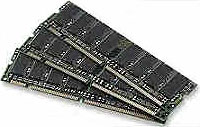 Earlier this month Samsung got a lot of attention when they
Earlier this month Samsung got a lot of attention when they  An Australian production company has made what they are claiming is the first music video shot entirely with mobile-phone cameras.
An Australian production company has made what they are claiming is the first music video shot entirely with mobile-phone cameras.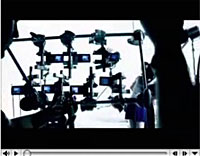 A multiplicity of mobiles (which look like Sony Ericsson k750i’s to us) were set up on frames and tripods with handheld footage recorded by four crew members who wandered around the band as they played, with the footage being sent via Bluetooth to laptops.
A multiplicity of mobiles (which look like Sony Ericsson k750i’s to us) were set up on frames and tripods with handheld footage recorded by four crew members who wandered around the band as they played, with the footage being sent via Bluetooth to laptops. The director of music video, Grant Marshall from Film Headquarters tries to explain, ‘We came up with this idea 18 months ago but couldn’t find a band that would embrace the risk and vision. P.U.S.A loved the concept and were brave enough to undertake the risk. This was a fantastic experience for all of us. The band was fabulous and incredibly professional.”
The director of music video, Grant Marshall from Film Headquarters tries to explain, ‘We came up with this idea 18 months ago but couldn’t find a band that would embrace the risk and vision. P.U.S.A loved the concept and were brave enough to undertake the risk. This was a fantastic experience for all of us. The band was fabulous and incredibly professional.”